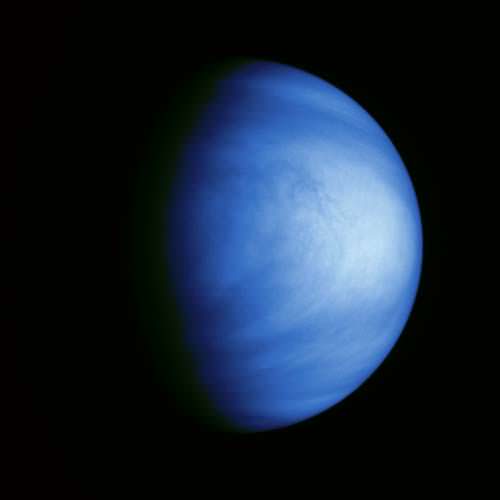Ready for another Where In The Universe Challenge? Here’s #142! Take a look and see if you can name where in the Universe this image is from. Give yourself extra points if you can name the spacecraft, telescope or instrument responsible for the image. We provide the image today, but won’t reveal the answer until later. This gives you a chance to mull over the image and provide your answer/guess in the comment section. And Please, no links or extensive explanations of what you think this is — give everyone the chance to guess.
UPDATE: The answer has now been posted below!
This is a “colorized” image of Venus was taken on February 14th, 1990 by the Galileo spacecraft. It was taken from a distance of almost 1.7 million miles, about 6 days after Galileo’s closest approach to the planet. In order to be able to see the subtle contrasts in the clouds in Venus’ upper atmosphere, scientists colorized to a bluish hue, as well as to indicate that it was taken through a UV filter.
This image shows the east-to-west-trending cloud banding, and scientists estimate the winds that flow from east to west are gusting at about 230mph. The smallest features visible are about 45 miles across. Scientists point out an intriguing filimentary dark pattern is seen immediately left of the bright region at the subsolar point (equatorial “noon”). North is at the top and the evening terminator is to the left.


That’s Venus in UV by ESA’s Venus Express. 🙂 Pretty.
J.Major is probably correct, but I’ll guess Neptune from Voyager.
uranus?
That’s venus, taken by magellan?
Definitely Venus. Not sure if it’s the Venus Express. I know when I was working @ the St. Louis Science Center in 2004, we handed out collectables with this image on it, so that predated the launch of Venus Express.
This could be the planet Neptune.
Venus. probably taken by Magellan. The blue is false coloring.
LC
Venus, yes, but a while back from Galileo as it swung by.
Venus, Messenger
Neptune by Voyager.
It Neptune from Voyager 2.
The cloud patterns tell me that its venus….
Messenger testing its cameras at a fly-by of Venus
Titan from Cassini can’t remember when but I think it was a false colour infra red image.
Venus – old technology camera
My official guess is Neptune by one of the Voyagers since that’s what I thought before I looked at the comments.
But after seeing the Venus answers… I realized those clouds are Venus and not Neptune. So you pulled the old “Change the Color of the Planet Trick” …Dirty Trick! LOL
Neptune’s clouds are more plain and even.
Nice try! The blue color might lead us to choose Neptune, but the swirling clouds say otherwise. I’ll go with Venus.
Depends what you mean by “old” 😉 Galileo’s SSI (CCD imager) took this on Feb 14, 1990, the same day that Voyager 1 took the Pale Blue Dot image. 🙂
It’s Venus in UV light I believe. (the UV that is — I’m sure about it being Venus.)
Okies, yall have convived me, it is Venus in UV. The cloud pattern is wrong for Neptune and the color is wrong for Uranus. But my personal opinion is that WITU should stick to visible light.
Doh! Galileo image. I really did think it was a Venus Express shot too…I was thinking of this one: http://www.esa.int/esa-mmg/mmg.pl?b=b&type=I&mission=Venus%20Express&single=y&start=63 and others like it. Oh well!
Idiots its not venus!!! Venus is quite near the sun. And you see the picture its dark blue mean its cold. It has to be one of the 4 gas planet. its either Uranus or Neptune.
Q1: Do the cloud patterns look like Neptune’s?
Q2: The bright light reflecting off the brighten disk tell you anything about the proximity to the Sun?
Q3: If you look at the oceans on Earth from space. Are they cold too?
Assuming your comment wasn’t a spoof, note that the image was made via an Ultra-Violet filter. Humans can’t see Ultra-Violet. [Maybe people of your species can.] Hence the people making the image had to choose a visible color to display the image and they chose to use shades of Blue. The same kinds of choices have to be made to display images of radar, infrared or gamma ray data etc.